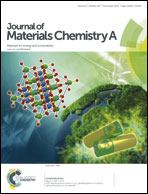In situ controllable synthesis of graphene oxide-based ternary magnetic molecularly imprinted polymer hybrid for efficient enrichment and detection of eight microcystins
Abstract
An in situ controllable approach for fabrication of a well-designed graphene oxide-based ternary magnetic molecularly imprinted polymer hybrid (T-MMIP hybrid) was developed. The GO sheet was firstly modified with Fe3O4 microspheres via a one-pot solvothermal method to prepare GO-Fe3O4. Then, the synthesized GO-Fe3O4 was used as the desired substrate for further in situ co-polymerization in the presence of a functional monomer (acrylamide, AM), cross-linking agent (divinylbenzene, DVB), and template molecule (microcystin-LR, MC-LR), followed by elution of the template molecule. The morphologies and structures of the T-MMIP hybrid were verified by scanning electron microscopy (SEM), transmission electron microscopy (TEM), X-ray diffraction (XRD), Fourier transform infrared spectroscopy (FTIR), Raman spectroscopy, X-ray photoelectron spectroscopy (XPS), vibrating sample magnetometer analysis (VSM), thermogravimetry analysis (TGA), Brunauer–Emmett–Teller analysis (BET), and fluorescence spectroscopy. The obtained T-MMIP hybrid showed an outstanding affinity towards eight similar structural microcystins (MC-RR, MC-YR, MC-LR, MC-LW, MC-LY, MC-LA, MC-LF, and MC-WR) in aqueous solution under the optimum conditions, and the enrichment factors of this material for the eight MCs were found to be above 2000. Compared with the literature, it showed that the synthesized T-MMIP hybrid binding with the optimal original template MC-LR had a significant improvement on the affinity and selectivity for a group of structurally related compounds.


 Please wait while we load your content...
Please wait while we load your content...